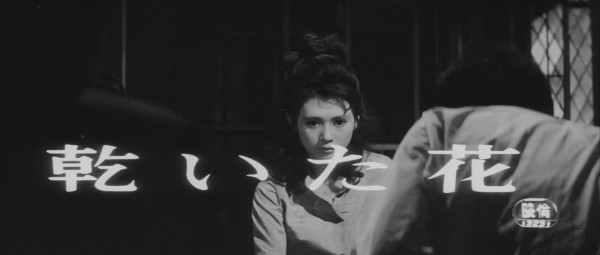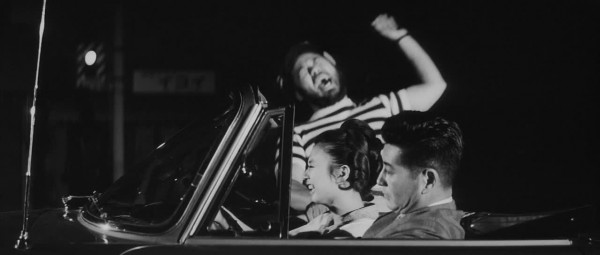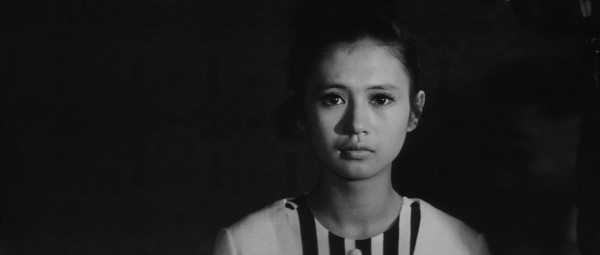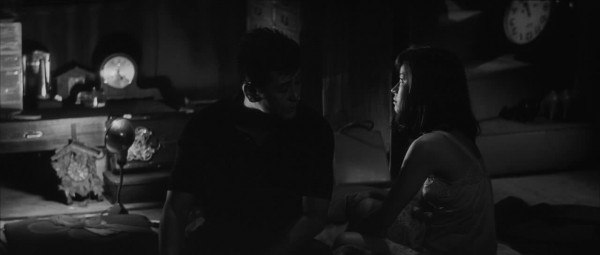Pale Flower
aka 乾いた花 aka Kawaita Hana

1964![]()
Written by Masaru Baba and Masahiro Shinoda
Based on the book by Shintaro Ishihara
Directed by Masahiro Shinoda

Pale Flower starts out slow and continues the leisurely pace, building up the complex web of characters and simmering gang drama. Muraki (Ryo Ikebe) is newly released from prison, after serving a few years for killing a rival gang member. By now the gangs are in a loose confederation as a third power has become a threat to both. The two former rival leaders spend part of their time arguing like old bickering lovers. Muraki is brought back into the swing of things, but kept out of any heavy action because of his recent release status. The reacquaintance with underworld activities results in one exciting point, a striking young woman (Mariko Kaga) who shows up at one of the local gambling houses, bets big, seems bored, and speaks to no one. Muraki manages to attract a scrap of attention from her when he matches one of her large bets.
After a few weeks of gambling together in silence, Muraki scores a conversation with her. She goes by Saeko, and the small time bets no longer excite her. Muraki says he can get her bigger action, he just needs to ask around for where the games are played now. They agree to meet up later in the week, and a partnership is born. Saeko is a thrill-seeker, zipping around in her sports car, betting big. She senses the danger in Muraki and it attracts her, but not in a sexual lust way. Simply being around him is enough. One look at Saeko answers all questions of why any guy would hang with her.

The increasing bets and Saeko’s danger chasing mirror the increasing threats from the real world. A cryptic guard at one of the games Muraki pegs for a maniac, and soon Muraki is being talked down dark alleys by a hidden killer. The upstart gang kills an important gang figure, and there must be a response of killing their leader. Muraki volunteers, his stretch of freedom growing sour at the same time his relationship with Saeko seems to be going south. But she reunites with him as he prepares to go off to do his job, seeing someone be murdered is a thrill she hasn’t experienced yet.
Muraki is a low-key gangster who seems bored with life in general and justifies his killing by talking down on mankind as a whole. His relationship with Saeko isn’t overtly sexual, but is two people at a similar point in life that come together because they click, and tension boils beneath the surface. Muraki has a woman who waited for him while he was away, she sleeps in the clock shop her family owns, the scenes there punctuated by the ticking of hundreds of clocks, a reminder of the limited length of life. She can’t stay away from Muraki even though he’s no good, and follows him, observing his relationship with Saeko.

Saeko (not her real name) is never fully revealed. As seen briefly, she has her day life in some sort of moneyed family where she’s the perfect daughter, but that is just a mask. Just as the theories that the super heroes are the real personas and Peter Parker or Bruce Wayne are the masks, so her is her civilian identity a cover, Saeko is the real and her other identity is unimportant. The point is obvious, but a flaw in Pale Flower is it not trusting you to make that conclusion, so specifically states that is the case.
Holy crap for the casting of Mariko Kaga! She’s perfect as Saeko, saying more with a silent look than many actresses take an entire film do convey. Much of her intensity is her striking beauty and how that becomes the focus of the room. Saeko is the titular “Pale Flower” (though the title translates more literally to “shy/withered flower”), the blossom that is fading away. Saeko’s seeking of thrills is ultimately self-destructive, much as Muraki’s gangster career. Saeko speeds around in her sports car, flying through the empty city streets at 2:30 am. At one point she gets into a race with another driver that ends in the most hilarious way possible. Muraki makes another connection with a young mobster that tries to kill him in retaliation for the man her murdered, who then tries to make amends and becomes a protege. The young man even cut off a finger in atonement, the location of which becomes a running gag throughout the film.
Pale Flower has the edges of being a gambling film (or a bakuto eiga, for those of you who like to drop random Japanese film terms when not needed), as much of the action in the middle takes place during sessions of hanafuda games. I don’t even know how the games were supposed to work, but they included enough gambling porn to keep the fanatics happy and avoided resorting to having the heroes have supernatural gambling winning powers. Saeko usually throws her money away each trip, the excitement comes from the act of gambling, not the thrill of winning. And there isn’t a clear winner in the movie, Pale Flower has the trappings of noir and the darker resolutions that brings.
Pale Flower is tops with the visuals, the empty streets at night, the confusing alleyways, and the gambling scenes shot with the many suited men seated before a white blanked where the action takes place. Masao Kosugi handed the cinematography for director Masahiro Shinoda (one of their many collaborations), the choice of focusing more on the visuals than the script angered co-screenwriter Masaru Baba (who was adapting a story by taiyo-zoku/sun tribe figurehead Shintaro Ishihara along with the director), and the resulting feud delayed the film’s release. While I think the visual focus improved the film in general, I’m not of the opinion that this is one of the greatest Japanese noirs of all time. It’s certainly no slouch, but the slow tone and distrust of the viewer to understand Saeko keep it out of the perfection bracket. Pale Flower is worth seeing, if only to argue about how important it is later, and to see how the late night race ends.

Rated 7/10 (black cat, art, tiger tat, owl time, card, card, card)
Please give feedback below!









